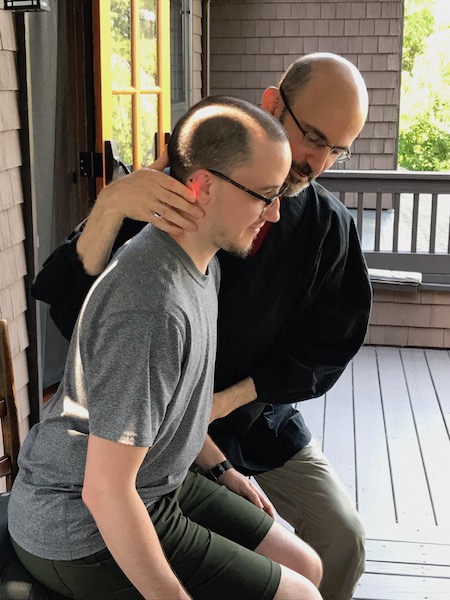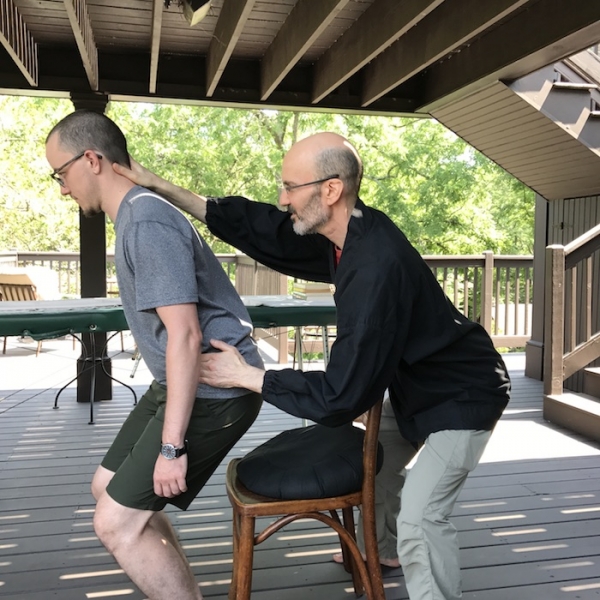Frequently Asked Questions (FAQs)
Why do we need the Alexander Technique?
We spend most of our lives sitting, standing and walking. These activities seem so familiar to us that we hardly notice them, and yet their influence on our well being is profound because we engage in them so often. We are, quite literally, shaped by what we do and how we do it. This fact makes our ordinary actions worthy of our attention and interest.
 Just as our basic activities shape us, the Alexander Technique can shape our basic activities, and for the better. With the AT, we can learn to sit, stand and walk with greater ease, efficiency and pleasure. We can learn to be upright without strain, and to be stable without rigidity. We have the opportunity to be balanced, mobile, flexible and free both in motion and at rest. As a result, our basic activities can become fun and fascinating rather than being a bore and a chore.
Just as our basic activities shape us, the Alexander Technique can shape our basic activities, and for the better. With the AT, we can learn to sit, stand and walk with greater ease, efficiency and pleasure. We can learn to be upright without strain, and to be stable without rigidity. We have the opportunity to be balanced, mobile, flexible and free both in motion and at rest. As a result, our basic activities can become fun and fascinating rather than being a bore and a chore.
Scientific studies have demonstrated the value of AT lessons. However, not all of the AT benefits cited on this website have been scientifically proven. Please feel free to read what the scientific literature has to say about the Alexander Technique here.
Who can benefit from the AT?
The Alexander Technique can be useful and stimulating for almost anyone at any age. However, people who study the AT tend to identify themselves with one or more of these groups:
People in pain: People who are in pain can find significant, lasting relief with the AT. This relief can happen because Alexander students learn to recognize and stop engaging in habitual movement patterns that contribute to pain or cause injury. Students can also learn to modify their own reaction to pain so that the reaction itself no longer contributes to their discomfort.
Performing artists and athletes: Performing artists and athletes often make exceptional demands of themselves while seeking to master their disciplines. Sometimes those demands compromise delicate joints or whole limbs to the point where pain can impair not only a person's proficiency but even her livelihood. The AT helps performers and athletes put their well being and professional sustainability squarely at the center of their lives.
People seeking self-knowledge and insight: To study the Alexander Technique is to study the self, to become a connoisseur of one's own habits, reactions and behavior. People who want to see themselves clearly and compassionately from an entirely new perspective will find plenty of grist for their mills by studying the AT. In addition, the patient self observation that is part and parcel of the AT can help students to relate more comfortably with other people.
 Is the Alexander Technique some sort of medical treatment or therapy?
Is the Alexander Technique some sort of medical treatment or therapy?
The AT is definitely not a form of medical treatment or therapy, nor is it intended to be a substitute for any kind of medical treatment or therapy. People who practice the AT are students, not patients, and AT teachers give their students lessons, not treatments or therapy. Think of learning the AT the way you would think of learning to play a musical instrument: you make regular appointments with your teacher to refine and improve how you play your instrument. However, the instrument you're learning to play here is your self.
If the Alexander Technique is so great, why haven't I heard more about it?
In Alexander, a lot of time is spent engaging in basic activities like moving from standing to sitting in a chair. It is easy to understand why the significance of these activities is inapparent to so many people who have performed them in the same way since their infancy. Moreover, we are culturally conditioned to see our basic activities as unimportant. Sitting, for example, is not seen as an end in itself — it merely serves other ends like working at one's desk or eating a meal. And yet, because the average American sits for 8 hours a day, the quantity and quality of our sitting has a major impact on our well being.
The Alexander Technique can teach us that what seems routine and unimportant is really quite important. During AT lessons, what usually seems old, settled and dull can become be fresh, spacious and intriguing. We can learn a great deal about ourselves just by examining our attitude toward these everyday activities. Re-learning the activities themselves can make our lives easier, simpler and more enjoyable.
How does the AT work?
The Alexander Technique is an educational process grounded in self care. This method of self care is based on the principles of awareness (seeing habits that cause strain, discomfort and inefficiency); inhibition (gradually diminishing the hold those habits have over us); and direction (replacing harmful habits with consciously directed movement patterns).
AT teachers impart the Alexander principles to students using gentle hands-on guidance and verbal instruction while students perform basic activities. The skilled touch of an AT teacher gives students the immediate experience of inhibiting habitual responses while consciously directing new, easier movement patterns. This nonverbal communication between teacher and student accelerates the learning process and is central to the Alexander Technique.
 What happens during an Alexander Technique lesson?
What happens during an Alexander Technique lesson?
Tim usually divides the time spent with each student into two parts that are distinct and complement one another. These parts are called chair work and table work. The "work" here is much more a matter of the student's thinking than of her doing anything physically taxing.
What is Alexander Technique "chair work?"
Chair work gives AT students an opportunity to meet a common stimulus that has strong habitual patterns associated with it. Using gentle touch and verbal cues, Tim helps students to recognize habits that make sitting painful, difficult or laborious. He then gently encourages students to replace those habits with fresh, beneficial choices that support their ease and well being. As a result, students can experience improved freedom of movement, less pain and lower energy expenditure during movement. Meanwhile, the act of moving into and out of a chair becomes a rich learning opportunity.
What is Alexander Technique "table work?"
Table work can allow the student to recognize and release unconscious holding patterns that are harder to detect while upright. With the release of those patterns, structural changes caused by the patterns over many years can gradually be reversed. While the student rests comfortably on a table, Tim's gentle touch, aided by gravity and time, imparts a sense of expansion and integration. Decompression occurs where the head and neck meet and the limbs are allowed to move slightly away from the torso. Therefore, table work can facilitate a lengthening spine, freedom of movement and easier breathing. In addition, students usually find table work deeply restorative and pleasant.
Alexander lessons may also involve working with a wide variety of other basic activities besides chair work. Breathing, walking, using a handheld device or picking something up from the floor are good examples of activities that can engaged in during an AT lesson.
What clothing is best for an Alexander Technique lesson?
Students should wear clothing that is neither very tight nor very loose because either extreme can inhibit free movement during an Alexander lesson. For women, slacks that are not too tight are a much better choice than skirts or dresses for both chair and table work.
What's the cost of a lesson?
An individualized 50-minute lesson costs $80. Two people can share an extended lesson, splitting both the 75 minutes and the $125 cost between themselves.
How many lessons will it take?
There are no hard and fast rules about the number of lessons a student will need, or want, to take. The goal of the learning is for the student to be able to practice the Alexander Technique independently. Because our habits are tenacious, it can take six months of weekly lessons to approach that goal. That said, some people study for shorter periods and get meaningful benefit from short-term study. Meanwhile, other students continue taking AT lessons for many years because they place a high value on learning about themselves and on improving their functional capacity.
Okay, so what's this Alexander Technique thing, really?
All living systems must support and maintain themselves under the influence of both gravity and time. The key to living sustainably, to living well, is to optimize the energy we use to support ourselves throughout our lives. We can be used by gravity — becoming progressively more pulled down, contracted, narrowed, stiffened and strained. Or, we can use gravity — becoming lighter and buoyant, with more flexibility, poise, grace and mobility. The Alexander Technique can teach you how to use gravity to your advantage and live a more expansive and open life.

